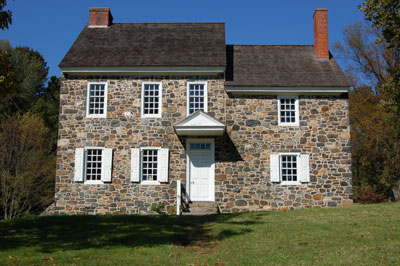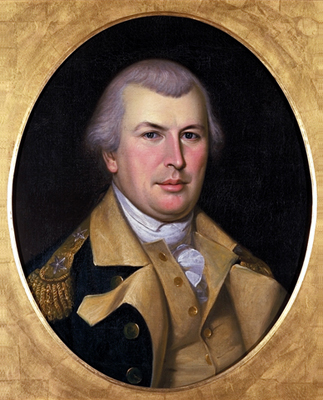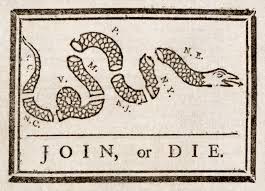The Battle of Brandywine: — Part 4 of 10
Washington Receives Conflicting Reports

The Benjamin Ring House, used as Washington's Headquarters during the battle
Washington directed the Americans from the Ring House, a residence about three quarters of a mile east of Chadd's Ford. Viewing the battle through a telescope, he must have been a little suspicious that something was afoot. He knew that Howe had all morning to bring his army in position to attack and yet he still hadn't. Washington had also seen the busy movements of the British troops in the hills and their impressive baggage train. Something was in the air. But what exactly?
One of the most fascinating aspects of the Battle of Brandywine is the great number of conflicting reports Washington received throughout the morning and early afternoon regarding whether Howe was moving troops north — towards the supply depots up at Reading? To ford the Brandywine elsewhere? To conduct a major flanking movement?
Washington heard a preliminary report at around 7 A.M. and a 10 A.M. report saying that Howe's troops were moving north. He heard a report at 9:30 A.M. and one from Major Spear at 1 P.M. that made him feel confident that it was just a feint and not a major troop movement. But the subsequent reports from Major Eustace, Colonel Bland, and a patriotic local squire named Thomas Cheyney finally convinced Washington that the reports of significant northern troop movement were real. Read more about the conflicting reports.
Surgeon Ebenezer Elmer traveling with the American army, put it most succinctly: "the reports were so Contradictory that it was difficult to make a proper disposition."
Washington Chooses a Course of Action

Nathanael Greene
Charles Wilson Peale, 1783
About noon, having received the reports from Ross and Bland that a large British column was moving north, Washington deduced that Howe had split his army. Washington felt he could deal a decisive blow to the divided British. He launched an assault aimed at Knyphausen's troops across the Brandywine.
Washington ordered part of Greene's troops and Maxwell's light infantry across the Brandywine at Chadd's Ford. The vanguard of this charge attacked an entrenching party from the British 49th regiment. They drove the British from their ground and in the process inflicted 30 casualties and killed a captain. Maxwell's infantrymen took possession of "a number of Entrenching Tools with which they [the British] were just throwing up a Battery."
Upstream, a regiment from Sullivan's command crossed the creek and started skirmishing with a British foot regiment. Downstream a group of Pennsylvania militia stationed at Pyle's Ford crossed the river and joined the fray.
At this time, Washington had dispatched Lord Stirling's and Stephen's brigades farther north on the east side of the creek toward Birmingham Meeting House in case Howe was indeed planning an attack from the north and not heading up to Reading.
Just before Washington was going to send the remainder of the army across the creek, he received a "definitive" message from Major Spear that there was no northern British troop movement. Washington decided "that the movement of the enemy was just a feint" and that they were returning to reinforce Knyphausen at Chadd's Ford.
Assuming that this was the case, he knew it would be folly to abandon his defensive position on the east side of the Creek to launch a full assault. Washington recalled his attacking troops back to the east side of the Creek. He also removed his defense against the flanking movement by recalling both Lord Stirling's and Stephen's brigades. This faulty report was very damaging, as it gave Howe the extra time he needed to march south into the flank of American forces.




